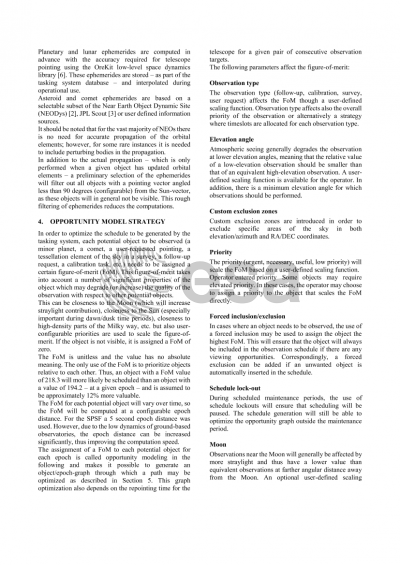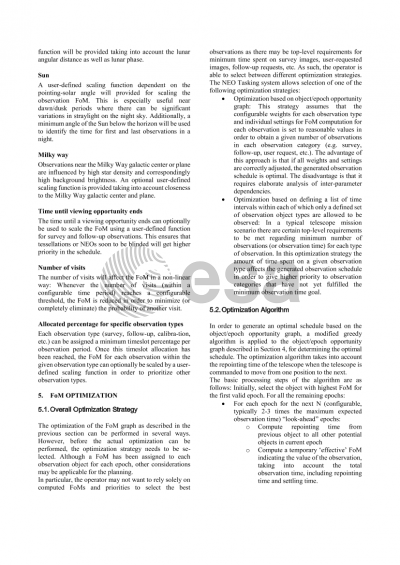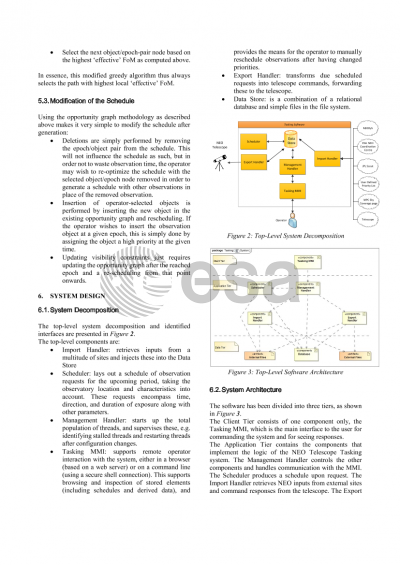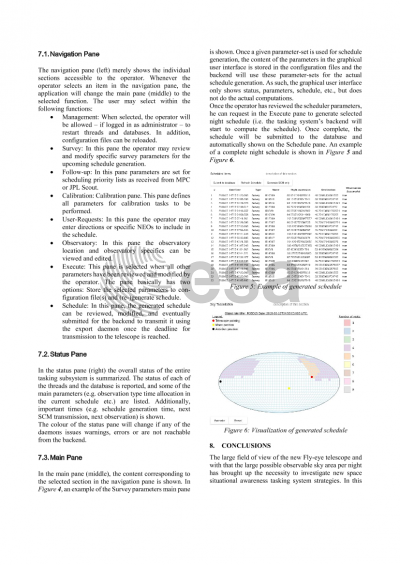Document details

Abstract
Over the past decade, space situational awareness (SSA) has gained more and more attention. A range of SSA programs has been launched globally, ranging from cataloguing of debris in near-Earth orbits to detection of asteroids with close approaches to Earth. The currently in-development ESA Fly-eye telescope aims at continuously scanning the sky for Near Earth Objects (NEOs). Important goals include maximizing the area that can be covered within a given time interval and to minimize the time for achieving a full coverage. Thus, the optimization of the telescope observation schedule is critical.
The NEO Fly-eye telescope Tasking system is responsible for planning and optimizing this schedule as a sequence of nightly observations to be made by the Fly-eye telescope. The planning and optimization approach is based on the experience gained from the development of the Sapphire Processing and Scheduling Facility (SPSF) of the Canadian Sapphire program, which has comparable optimization goals. In addition, the Fly-eye Tasking system allows the inclusion of the latest available NEO observation information and customizations such as user-defined observation targets. Optimization problems of this nature are sufficiently complex that it is not practical to compute a global optimum in a timely manner on standard processing resources. Hence, a heuristic is employed in order to achieve good optimization within a few seconds using a normal processor.
The logic behind the Fly-eye telescope Tasking system is based on the concept of opportunity modelling. Opportunity modelling entails defining for each of a specific set of aspects of a potential observation a “figure of merit” function that is included in the calculation of the relative value of each observation. The combination of the figure of merits of all parameters results in an observation opportunity graph. This expresses the relative value of performing an observation at a certain time.
Optimizing the aforementioned model strategy, the Tasking system endeavours to ensure that the most relevant observations are included in each nightly schedule, taking into account the telescope’s own previous observations as well as recent observations by other telescopes. The observation schedule can be adapted by the operator to include observations taking information from priority lists from various sources, including the Minor Planet Center and JPL Scout, sky coverage information, and operator defined observation targets.
The concept of opportunity modelling used for the Fly-eye telescope Tasking system was already successfully employed in the SPSF for scheduling RSO (Resident Space Objects) image acquisitions for the Canadian Sapphire space surveillance mission. This space-born telescope monitors space debris and satellites within an orbit 6,000 to 40,000 kilometres above Earth, providing data to the US Space Surveillance Network, and operational since launch in 2013. The Sapphire scheduling system, which determines the observations to be made, generates a daily schedule for around actual 300 observations from between 700 to 800 potential observation targets.
Although the goals of the Fly-eye telescope for NEO observations and the Sapphire mission for space debris tracking are substantially different in nature, it is shown that the planning aspects for each have very similar demands, and opportunity modelling is applicable to both.
Preview









